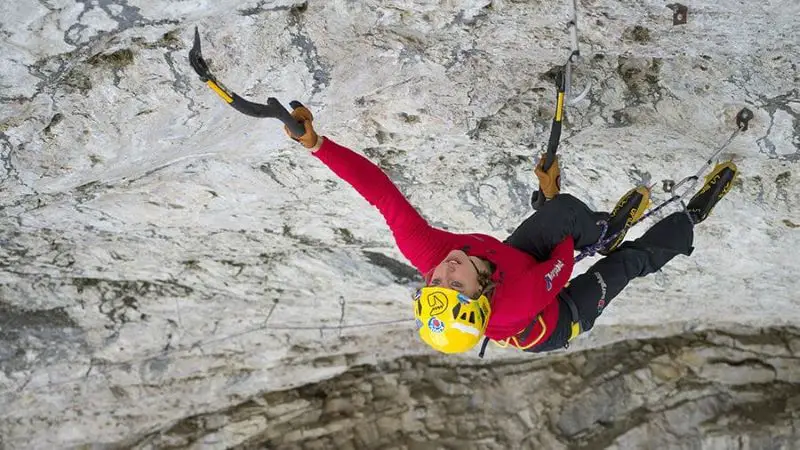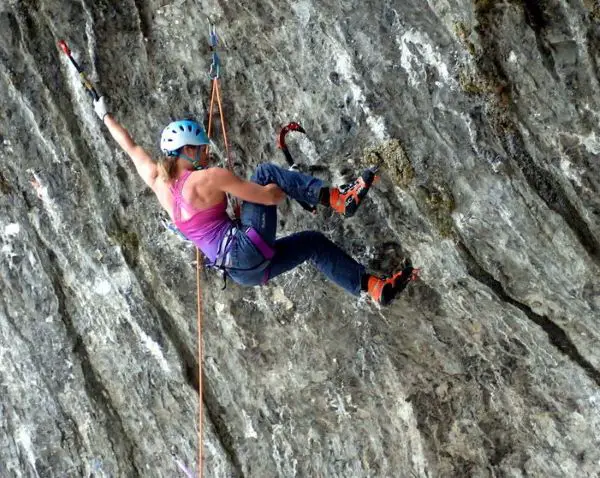Ever watched an ice climber and thought they were doing some sort of aerial yoga? That’s probably the figure four or the figure nine in action. It’s the coolest yet strangest move you’ll ever see in climbing.
Imagine hanging off an icy cliff, then casually draping your right leg over your left arm, like you’re just chilling on a Sunday afternoon (although the move is not as chilled as it looks!).
This climbing technique has also made an appearance in rock climbing, and if you regularly watch the IFSC competitions, you’ll probably get at least one climber during the comps pulling out this move.
There are two types of figures you can do; the figure of four and the figure of nine.
Let’s look at them in a bit more detail!
Ice Climbing Techniques: Figure Four & Nine
What Is Figure Four Climbing?
The climbing figure four is the ice climbing technique where you wrap one leg over the opposite arm. You do this all while hanging on ice axes. Crazy, right?
Ice climbers use this technique to gain more height, especially when the footholds aren’t great.
Instead of using your arms to pull yourself up, you are leveraging your legs and core to help you with getting to the next move.

What Is A Climbing Figure Nine?
A figure nine is similar to the figure four except you wrap your leg over the same arm; left leg to left arm. The Figure nine is used to transition from a figure four or to traverse along.

There are three ways you can do a figure four and nine; low, medium and high. The low means you have your arms fully extended. This is the most comfortable way to sit in a figure four or nine but when it comes to reaching up for the next hold, you’ll need to pull up with your body to get to your next hold.
The medium and high positions have your arms fully engaged. This does feel uncomfortable and you can’t rest for long, but when it comes to making the next move, you don’t have to extend your body as much.
How To Do A Figure Four & Nine
So, how do you pull off this gravity-defying move? First, you’ve got to be hanging out on some overhung terrain on really good holds (slab is not the place to be doing this). Pull those legs up like you’re about to do a really intense ab crunch, then swing one leg over your arm.
How To Do Figure Four
To do a figure four, you want to hook your knee around your opposite arm. Wrap your leg around the wrist, or just above it, not around the elbow.
You’ll see a lot of climbers, especially rock climbers, pinching their elbows. If you bring your leg too high on your arm, you’re movements will be very restricted.
Avoid hunching your back, pull up with your shoulders and straighten your back. This is what will give you the reach you need for the next hold.
How To Do A Figure Nine
With a figure nine, you want to hook your leg over the same arm, for example, right leg over right arm. For figure nine, your arm positon is slightly different as you can pinch the elbow rather than the wrist.
Why Do A Figure Four/Figure Nine?
Here are a few reasons why you might want to do a figure of four or nine:
1) Navigating Overhung Terrain
These techniques are ideal for steep, overhung routes where footholds are scarce. By using your leg as a lever, you create a stable platform to move from.
2) Gain More Height
By leveraging the body in a figure four or nine, climbers can push off their anchored leg to gain additional height, reaching holds that might otherwise be out of reach.
3) Static Movement For Long Reaches
When dynamic moves are too risky or impractical, figure fours and nines allow for controlled, static reaches to distant holds.
4) Stability For Gear Placement
They provide a stable position to place or remove gear without the need for footholds, which is crucial in complex ice-climbing scenarios.
5) Freeing Up An Arm
Sometimes you need an extra hand to adjust your position or retrieve gear. These moves allow you to do so while maintaining stability.
6) Downward Force On Axes
In precarious placements, pulling downwards on your axes is safer than pulling laterally. These techniques ensure your weight is directed down, securing your axes in place.
7) Conserving Energy
Although physically demanding, these techniques can be less tiring than repeatedly trying dynamic moves and locking off, especially in overhung terrain.
8) Training for Core & Upper Body Strength
Practicing figure fours and nines can significantly improve core, shoulder, and arm strength, beneficial for various climbing disciplines.
9) Rock Climbing Applications
Rare but useful, these moves can be applied in rock climbing, particularly in bouldering, to maintain body position during long reaches to poor holds.
Watch ice climbing pro, Will Gadd show you everything you need to know about ice climbing:



